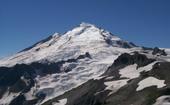Mount Baker (elevation 10,778 feet, 3,285 m) is a glaciated andesitic stratovolcano in the Cascades of Washington State in the United States about 30 miles (50km) due east of the city of Bellingham, Whatcom County. It is also easily visible from much of Greater Victoria, Greater Vancouver and the Fraser Valley just across the Canadian border to the north, and especially from the communities of Mission and Abbotsford, both about 45 kilometres (28 miles) east of Vancouver, BC—as well as from some locations in Everett and even Seattle to the southwest.
After Mount Rainier, Baker is the most heavily glaciated of the Cascade volcanoes: the volume of snow and ice on Mount Baker (0.43 cubic miles, 1.8 cubic kilometers) is greater than that of all the other Cascades volcanoes (except Rainier) combined. It is also one of the snowiest places in the world: in 1999, Mount Baker set the (unofficial) world record for snowfall in a single season. (1124 inches/93.67 feet/2855 cm)
Geology
The present-day cone of Mount Baker is relatively young, perhaps less than 30,000 years old, but it sits atop a similar older volcanic cone called Black Buttes volcano which was active between 500,000 and 300,000 years ago. Much of Mount Baker's earlier geological record was eroded away during the last ice age (which culminated 15,000-20,000 years ago), by thick ice sheets that filled the valleys and covered much of the region. In the last 14,000 years, the area around the mountain has been largely ice free, but the mountain itself remains heavily mantled with snow and ice.
Isolated ridges of lava and hydrothermally altered rock, especially in the area of Sherman Crater, are exposed between glaciers on the upper flanks of the volcano: the lower flanks are steep and heavily vegetated. The volcano rests on a foundation of non-volcanic rocks in a region that is largely non-volcanic in origin.
Deposits which record the last 14,000 years at Mount Baker indicate that Mount Baker has not had highly explosive eruptions like those of Mount St. Helens or Glacier Peak, nor has it erupted frequently. During this period only four episodes of magmatic eruptive activity can be definitively recognized. Magmatic eruptions have produced tephra, pyroclastic flows, and lava flows from summit vents and from the Schriebers Meadow cinder cone. However, the most destructive and most frequent events at Mount Baker have been debris flows and debris avalanches, many, if not most, of which were not related to magmatic activity but may have been induced by steam emissions, earthquakes, heavy rainfall, or in some other way.
Historical activity at Mount Baker includes several explosions during the mid-19th century, which were witnessed from the Bellingham area, and numerous small-volume debris avalanches since the late 1950s. In 1975, increased fumarolic activity in the Sherman Crater area caused concern that an eruption might be imminent. Additional monitoring equipment was installed and several geophysical surveys were conducted to try to detect the movement of magma. The level of Baker Lake was lowered and people were restricted from the area due to concerns that an eruption-induced debris avalanche or debris flow might enter Baker Lake and displace enough water to either cause a wave to overtop the Upper Baker Dam or cause complete failure of the dam. However, few anomalies other than the increased heat flow were recorded during the geophysical surveys, nor were any other precursory activities observed to indicate that magma was moving up into the volcano. An increased level of fumarolic activity has continued at Mount Baker from 1975 to the present, but there are no other changes that suggest that magma movement is involved.
Easton Glacier (on the south flank) in 2003.
There are 10 main glaciers on the mountain. All retreated during the first half of the century, advanced from 1950-1975 and have been retreating increasingly rapidly since 1980. The Coleman Glacier is the largest with a surface area of 5.2 km² (Post et al., 1971). The other large glaciers, with areas greater than 2.5 km², are Roosevelt, Mazama, Park, Boulder, Easton and Deming Glaciers.
